Research Paper: Aggression and the Impact of Social Influences
VerifiedAdded on 2023/01/13
|7
|1098
|86
Essay
AI Summary
This essay provides a comprehensive overview of aggression, defining the concept and exploring its various dimensions. The paper delves into the factors that influence aggression, with a particular emphasis on the significant role of social determinants. It presents a detailed analysis of how societal influences, such as exposure to violence, social reinforcement, and cultural norms, contribute to aggressive behaviors. The essay further examines the prevalence of aggression across different countries, referencing statistical data to illustrate the impact of these factors. By analyzing the interplay of these elements, the essay aims to highlight the critical importance of social factors in shaping human aggression and advocate for further research into effective prevention strategies. The student assignment follows APA format and includes a title page, references, and supporting figures.
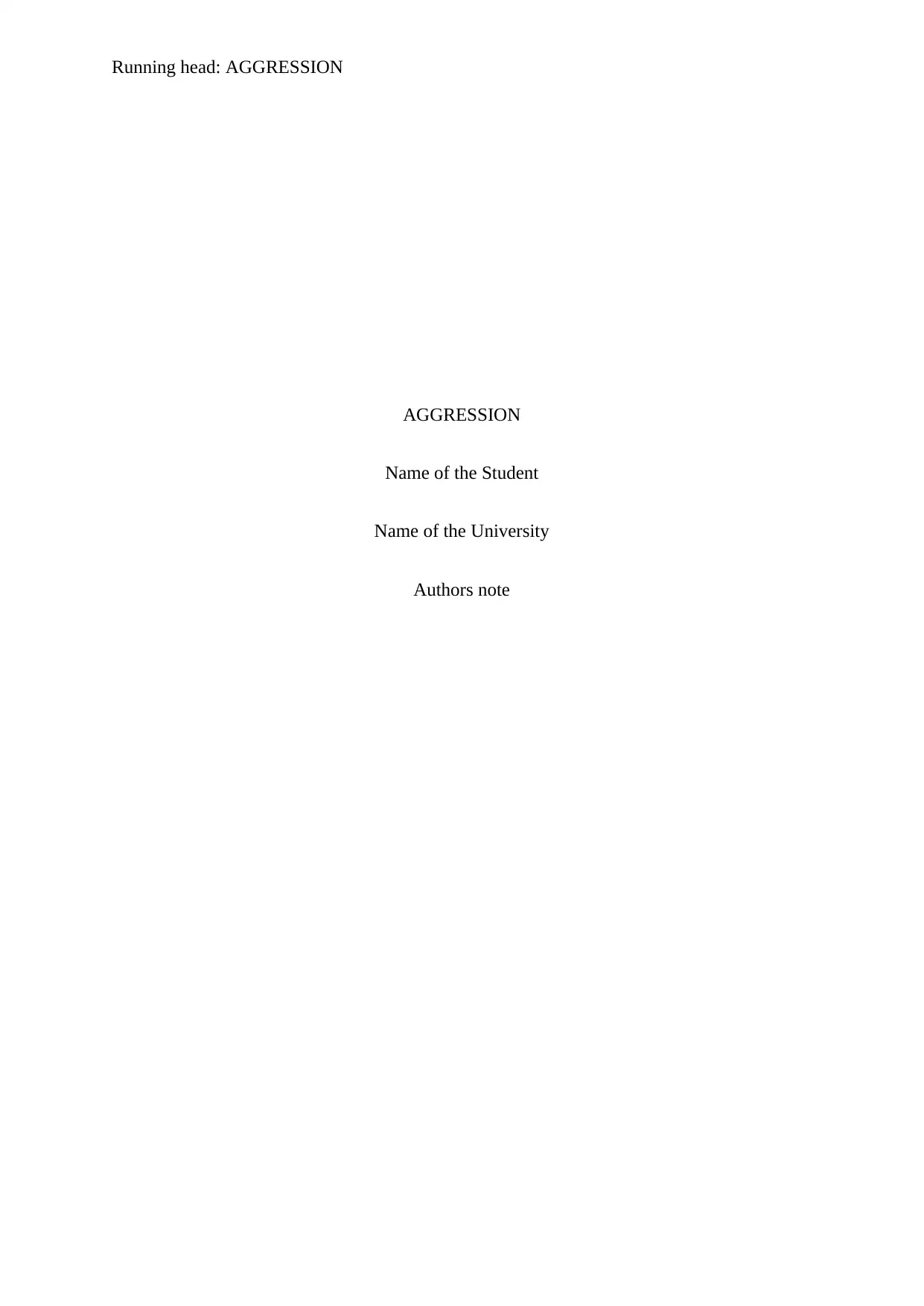
Running head: AGGRESSION
AGGRESSION
Name of the Student
Name of the University
Authors note
AGGRESSION
Name of the Student
Name of the University
Authors note
Paraphrase This Document
Need a fresh take? Get an instant paraphrase of this document with our AI Paraphraser
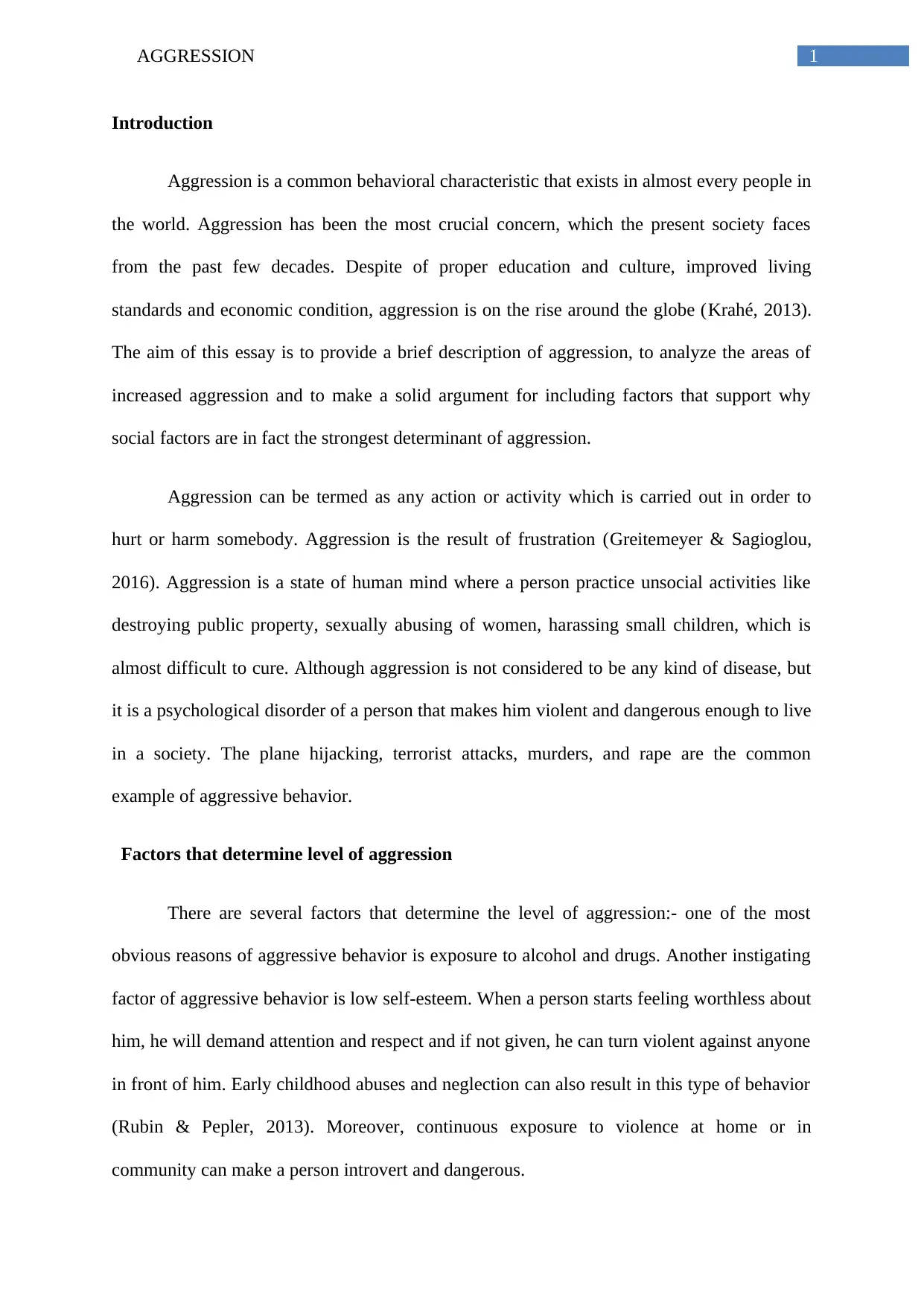
1AGGRESSION
Introduction
Aggression is a common behavioral characteristic that exists in almost every people in
the world. Aggression has been the most crucial concern, which the present society faces
from the past few decades. Despite of proper education and culture, improved living
standards and economic condition, aggression is on the rise around the globe (Krahé, 2013).
The aim of this essay is to provide a brief description of aggression, to analyze the areas of
increased aggression and to make a solid argument for including factors that support why
social factors are in fact the strongest determinant of aggression.
Aggression can be termed as any action or activity which is carried out in order to
hurt or harm somebody. Aggression is the result of frustration (Greitemeyer & Sagioglou,
2016). Aggression is a state of human mind where a person practice unsocial activities like
destroying public property, sexually abusing of women, harassing small children, which is
almost difficult to cure. Although aggression is not considered to be any kind of disease, but
it is a psychological disorder of a person that makes him violent and dangerous enough to live
in a society. The plane hijacking, terrorist attacks, murders, and rape are the common
example of aggressive behavior.
Factors that determine level of aggression
There are several factors that determine the level of aggression:- one of the most
obvious reasons of aggressive behavior is exposure to alcohol and drugs. Another instigating
factor of aggressive behavior is low self-esteem. When a person starts feeling worthless about
him, he will demand attention and respect and if not given, he can turn violent against anyone
in front of him. Early childhood abuses and neglection can also result in this type of behavior
(Rubin & Pepler, 2013). Moreover, continuous exposure to violence at home or in
community can make a person introvert and dangerous.
Introduction
Aggression is a common behavioral characteristic that exists in almost every people in
the world. Aggression has been the most crucial concern, which the present society faces
from the past few decades. Despite of proper education and culture, improved living
standards and economic condition, aggression is on the rise around the globe (Krahé, 2013).
The aim of this essay is to provide a brief description of aggression, to analyze the areas of
increased aggression and to make a solid argument for including factors that support why
social factors are in fact the strongest determinant of aggression.
Aggression can be termed as any action or activity which is carried out in order to
hurt or harm somebody. Aggression is the result of frustration (Greitemeyer & Sagioglou,
2016). Aggression is a state of human mind where a person practice unsocial activities like
destroying public property, sexually abusing of women, harassing small children, which is
almost difficult to cure. Although aggression is not considered to be any kind of disease, but
it is a psychological disorder of a person that makes him violent and dangerous enough to live
in a society. The plane hijacking, terrorist attacks, murders, and rape are the common
example of aggressive behavior.
Factors that determine level of aggression
There are several factors that determine the level of aggression:- one of the most
obvious reasons of aggressive behavior is exposure to alcohol and drugs. Another instigating
factor of aggressive behavior is low self-esteem. When a person starts feeling worthless about
him, he will demand attention and respect and if not given, he can turn violent against anyone
in front of him. Early childhood abuses and neglection can also result in this type of behavior
(Rubin & Pepler, 2013). Moreover, continuous exposure to violence at home or in
community can make a person introvert and dangerous.
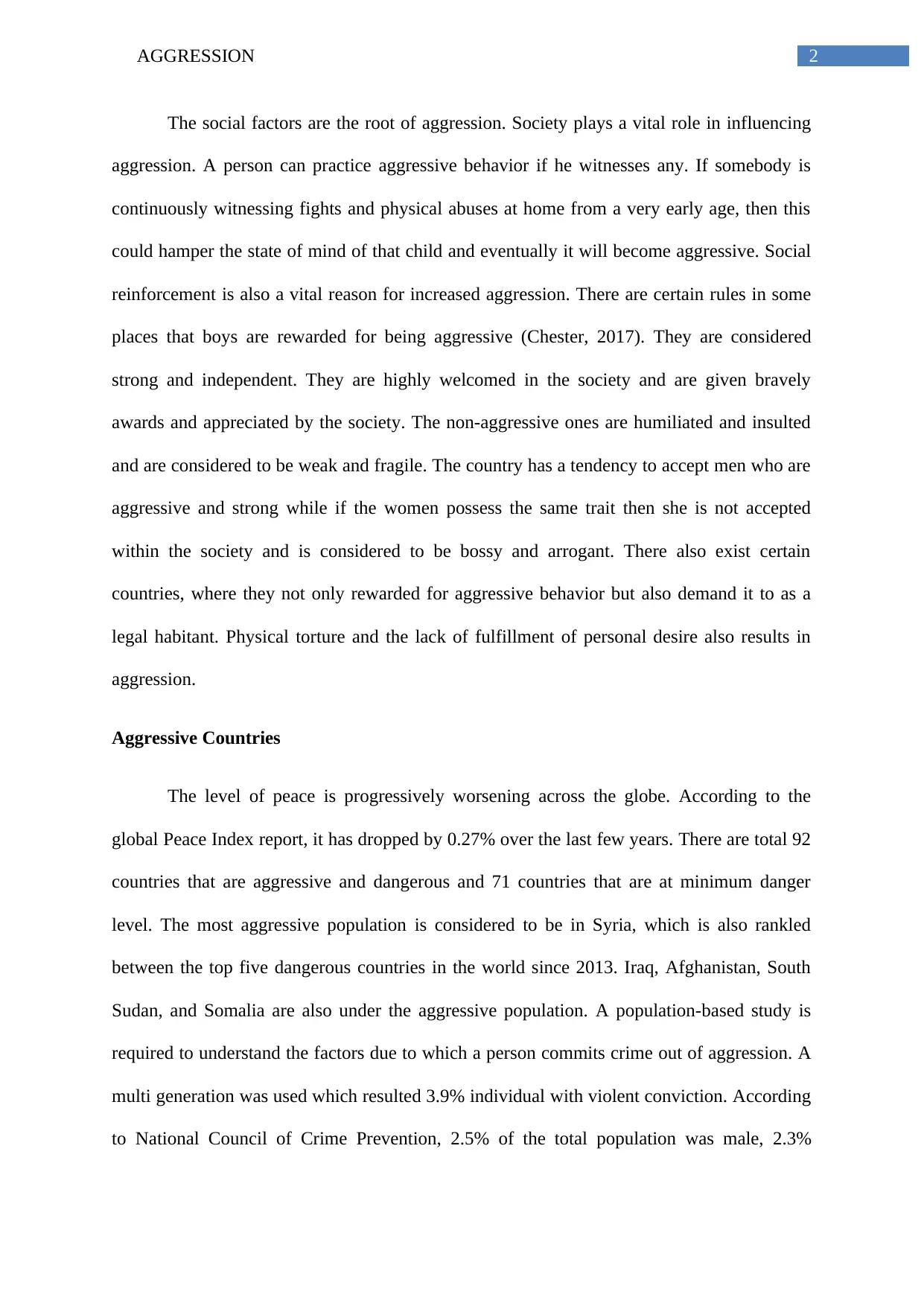
2AGGRESSION
The social factors are the root of aggression. Society plays a vital role in influencing
aggression. A person can practice aggressive behavior if he witnesses any. If somebody is
continuously witnessing fights and physical abuses at home from a very early age, then this
could hamper the state of mind of that child and eventually it will become aggressive. Social
reinforcement is also a vital reason for increased aggression. There are certain rules in some
places that boys are rewarded for being aggressive (Chester, 2017). They are considered
strong and independent. They are highly welcomed in the society and are given bravely
awards and appreciated by the society. The non-aggressive ones are humiliated and insulted
and are considered to be weak and fragile. The country has a tendency to accept men who are
aggressive and strong while if the women possess the same trait then she is not accepted
within the society and is considered to be bossy and arrogant. There also exist certain
countries, where they not only rewarded for aggressive behavior but also demand it to as a
legal habitant. Physical torture and the lack of fulfillment of personal desire also results in
aggression.
Aggressive Countries
The level of peace is progressively worsening across the globe. According to the
global Peace Index report, it has dropped by 0.27% over the last few years. There are total 92
countries that are aggressive and dangerous and 71 countries that are at minimum danger
level. The most aggressive population is considered to be in Syria, which is also rankled
between the top five dangerous countries in the world since 2013. Iraq, Afghanistan, South
Sudan, and Somalia are also under the aggressive population. A population-based study is
required to understand the factors due to which a person commits crime out of aggression. A
multi generation was used which resulted 3.9% individual with violent conviction. According
to National Council of Crime Prevention, 2.5% of the total population was male, 2.3%
The social factors are the root of aggression. Society plays a vital role in influencing
aggression. A person can practice aggressive behavior if he witnesses any. If somebody is
continuously witnessing fights and physical abuses at home from a very early age, then this
could hamper the state of mind of that child and eventually it will become aggressive. Social
reinforcement is also a vital reason for increased aggression. There are certain rules in some
places that boys are rewarded for being aggressive (Chester, 2017). They are considered
strong and independent. They are highly welcomed in the society and are given bravely
awards and appreciated by the society. The non-aggressive ones are humiliated and insulted
and are considered to be weak and fragile. The country has a tendency to accept men who are
aggressive and strong while if the women possess the same trait then she is not accepted
within the society and is considered to be bossy and arrogant. There also exist certain
countries, where they not only rewarded for aggressive behavior but also demand it to as a
legal habitant. Physical torture and the lack of fulfillment of personal desire also results in
aggression.
Aggressive Countries
The level of peace is progressively worsening across the globe. According to the
global Peace Index report, it has dropped by 0.27% over the last few years. There are total 92
countries that are aggressive and dangerous and 71 countries that are at minimum danger
level. The most aggressive population is considered to be in Syria, which is also rankled
between the top five dangerous countries in the world since 2013. Iraq, Afghanistan, South
Sudan, and Somalia are also under the aggressive population. A population-based study is
required to understand the factors due to which a person commits crime out of aggression. A
multi generation was used which resulted 3.9% individual with violent conviction. According
to National Council of Crime Prevention, 2.5% of the total population was male, 2.3%
⊘ This is a preview!⊘
Do you want full access?
Subscribe today to unlock all pages.

Trusted by 1+ million students worldwide
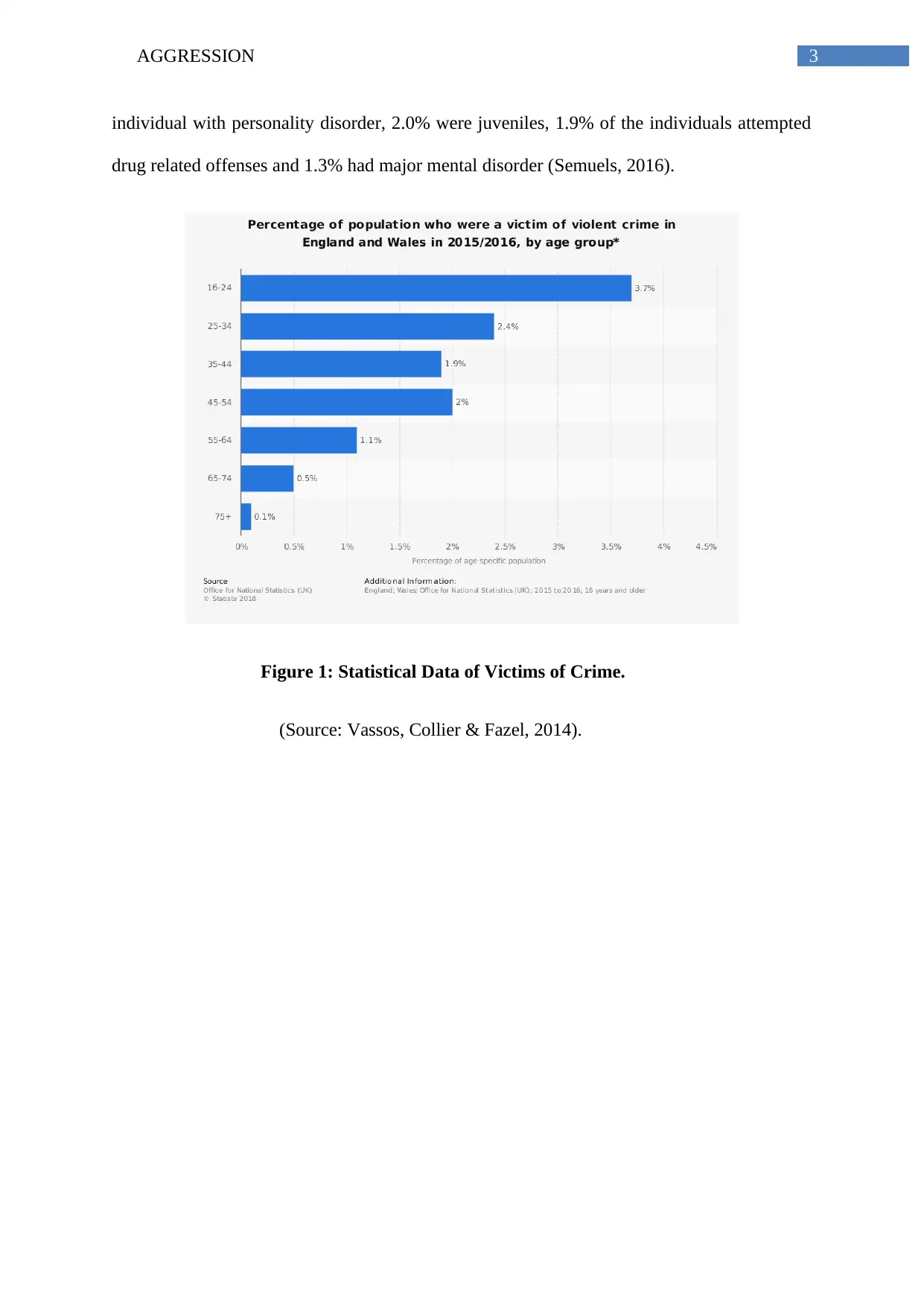
3AGGRESSION
individual with personality disorder, 2.0% were juveniles, 1.9% of the individuals attempted
drug related offenses and 1.3% had major mental disorder (Semuels, 2016).
Figure 1: Statistical Data of Victims of Crime.
(Source: Vassos, Collier & Fazel, 2014).
individual with personality disorder, 2.0% were juveniles, 1.9% of the individuals attempted
drug related offenses and 1.3% had major mental disorder (Semuels, 2016).
Figure 1: Statistical Data of Victims of Crime.
(Source: Vassos, Collier & Fazel, 2014).
Paraphrase This Document
Need a fresh take? Get an instant paraphrase of this document with our AI Paraphraser
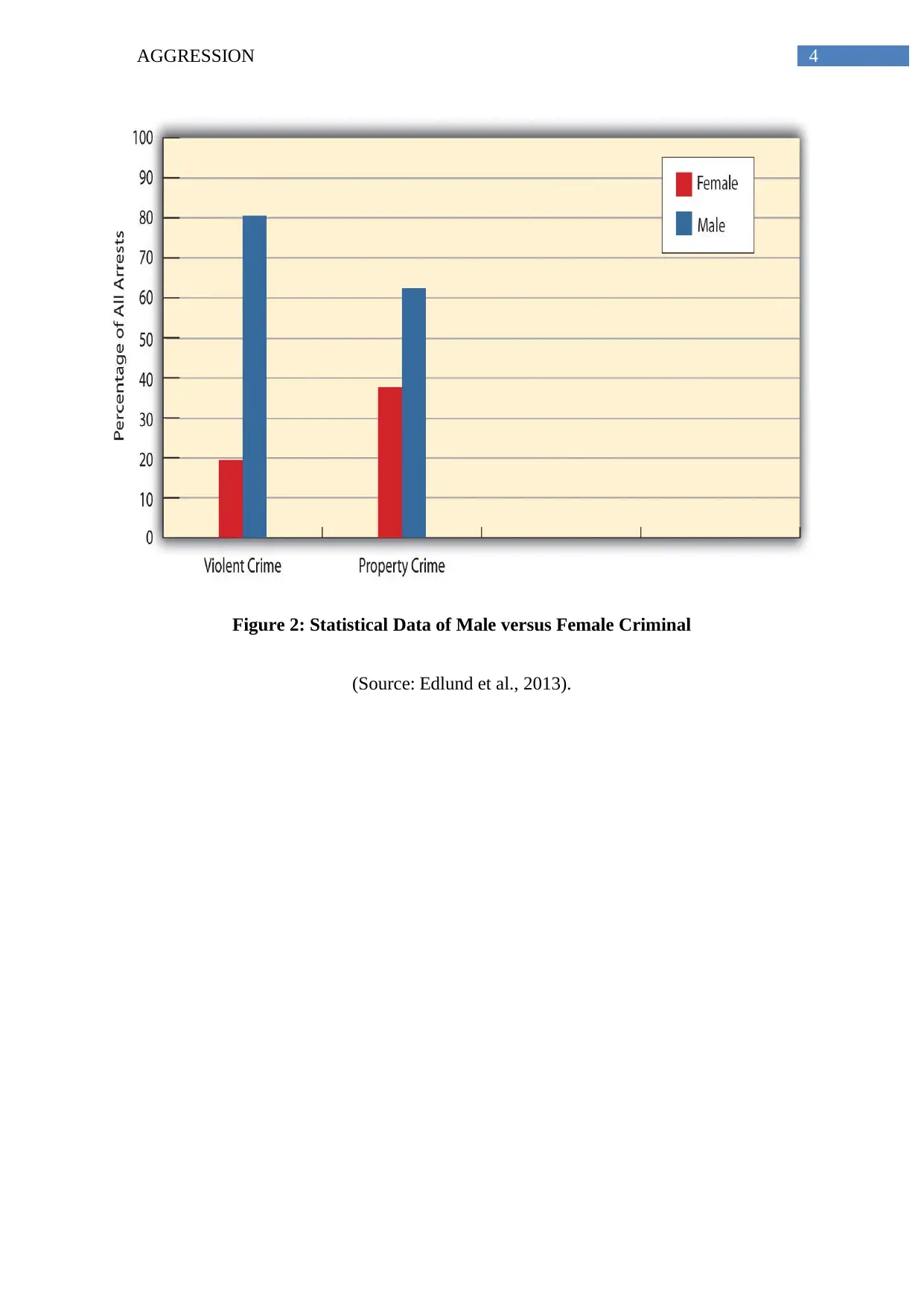
4AGGRESSION
Figure 2: Statistical Data of Male versus Female Criminal
(Source: Edlund et al., 2013).
Figure 2: Statistical Data of Male versus Female Criminal
(Source: Edlund et al., 2013).
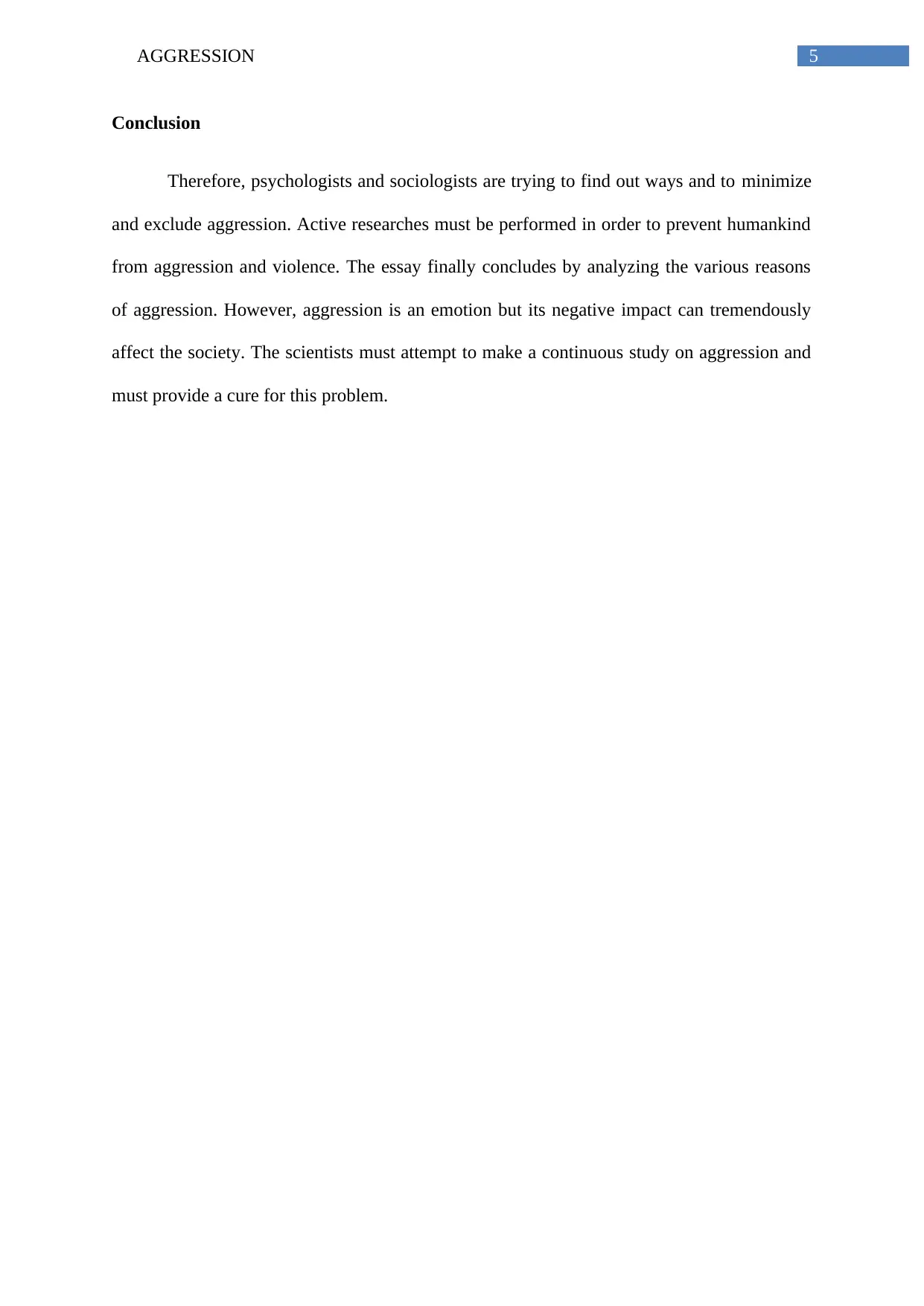
5AGGRESSION
Conclusion
Therefore, psychologists and sociologists are trying to find out ways and to minimize
and exclude aggression. Active researches must be performed in order to prevent humankind
from aggression and violence. The essay finally concludes by analyzing the various reasons
of aggression. However, aggression is an emotion but its negative impact can tremendously
affect the society. The scientists must attempt to make a continuous study on aggression and
must provide a cure for this problem.
Conclusion
Therefore, psychologists and sociologists are trying to find out ways and to minimize
and exclude aggression. Active researches must be performed in order to prevent humankind
from aggression and violence. The essay finally concludes by analyzing the various reasons
of aggression. However, aggression is an emotion but its negative impact can tremendously
affect the society. The scientists must attempt to make a continuous study on aggression and
must provide a cure for this problem.
⊘ This is a preview!⊘
Do you want full access?
Subscribe today to unlock all pages.

Trusted by 1+ million students worldwide
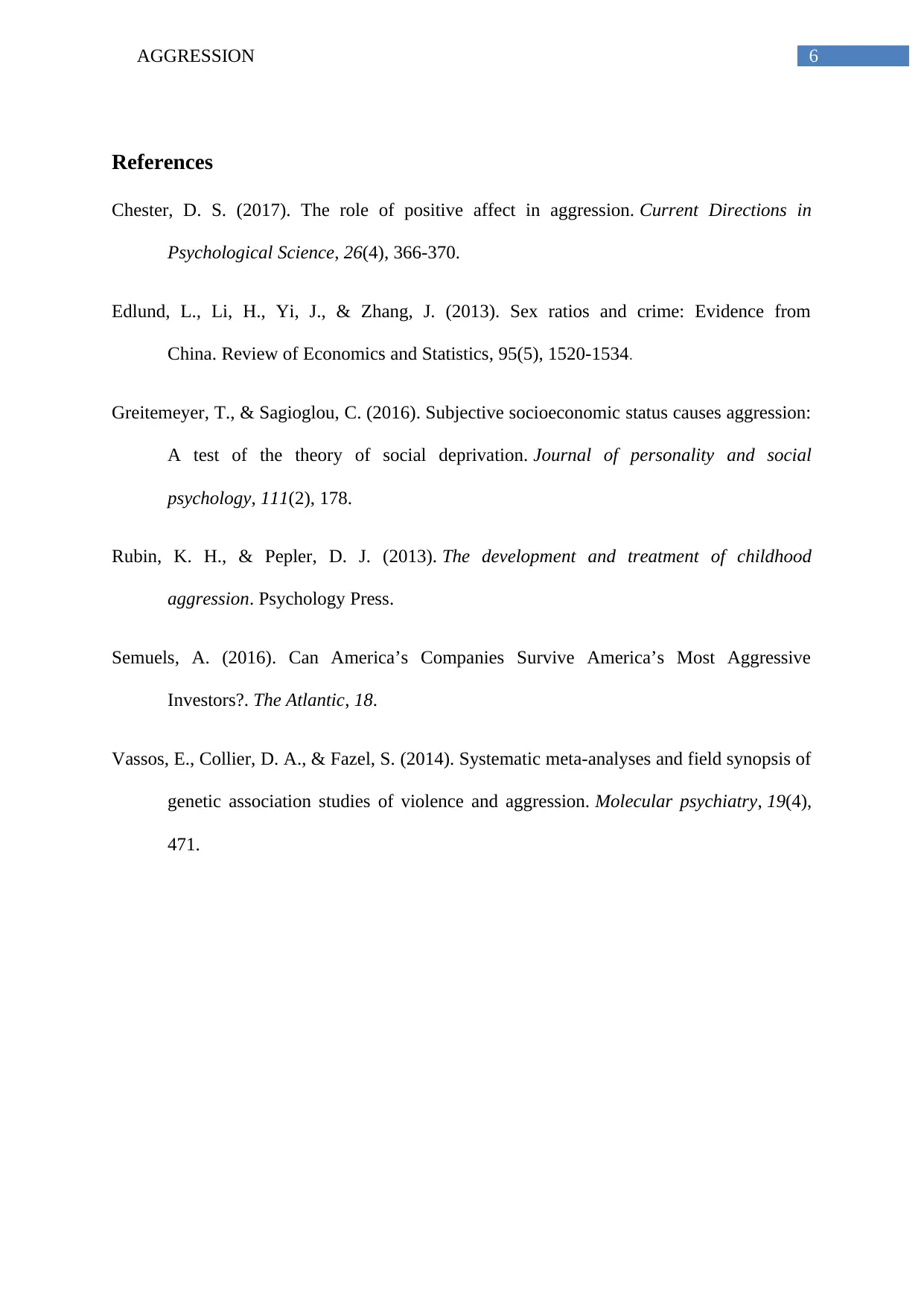
6AGGRESSION
References
Chester, D. S. (2017). The role of positive affect in aggression. Current Directions in
Psychological Science, 26(4), 366-370.
Edlund, L., Li, H., Yi, J., & Zhang, J. (2013). Sex ratios and crime: Evidence from
China. Review of Economics and Statistics, 95(5), 1520-1534.
Greitemeyer, T., & Sagioglou, C. (2016). Subjective socioeconomic status causes aggression:
A test of the theory of social deprivation. Journal of personality and social
psychology, 111(2), 178.
Rubin, K. H., & Pepler, D. J. (2013). The development and treatment of childhood
aggression. Psychology Press.
Semuels, A. (2016). Can America’s Companies Survive America’s Most Aggressive
Investors?. The Atlantic, 18.
Vassos, E., Collier, D. A., & Fazel, S. (2014). Systematic meta-analyses and field synopsis of
genetic association studies of violence and aggression. Molecular psychiatry, 19(4),
471.
References
Chester, D. S. (2017). The role of positive affect in aggression. Current Directions in
Psychological Science, 26(4), 366-370.
Edlund, L., Li, H., Yi, J., & Zhang, J. (2013). Sex ratios and crime: Evidence from
China. Review of Economics and Statistics, 95(5), 1520-1534.
Greitemeyer, T., & Sagioglou, C. (2016). Subjective socioeconomic status causes aggression:
A test of the theory of social deprivation. Journal of personality and social
psychology, 111(2), 178.
Rubin, K. H., & Pepler, D. J. (2013). The development and treatment of childhood
aggression. Psychology Press.
Semuels, A. (2016). Can America’s Companies Survive America’s Most Aggressive
Investors?. The Atlantic, 18.
Vassos, E., Collier, D. A., & Fazel, S. (2014). Systematic meta-analyses and field synopsis of
genetic association studies of violence and aggression. Molecular psychiatry, 19(4),
471.
1 out of 7
Related Documents
Your All-in-One AI-Powered Toolkit for Academic Success.
+13062052269
info@desklib.com
Available 24*7 on WhatsApp / Email
![[object Object]](/_next/static/media/star-bottom.7253800d.svg)
Unlock your academic potential
Copyright © 2020–2025 A2Z Services. All Rights Reserved. Developed and managed by ZUCOL.



